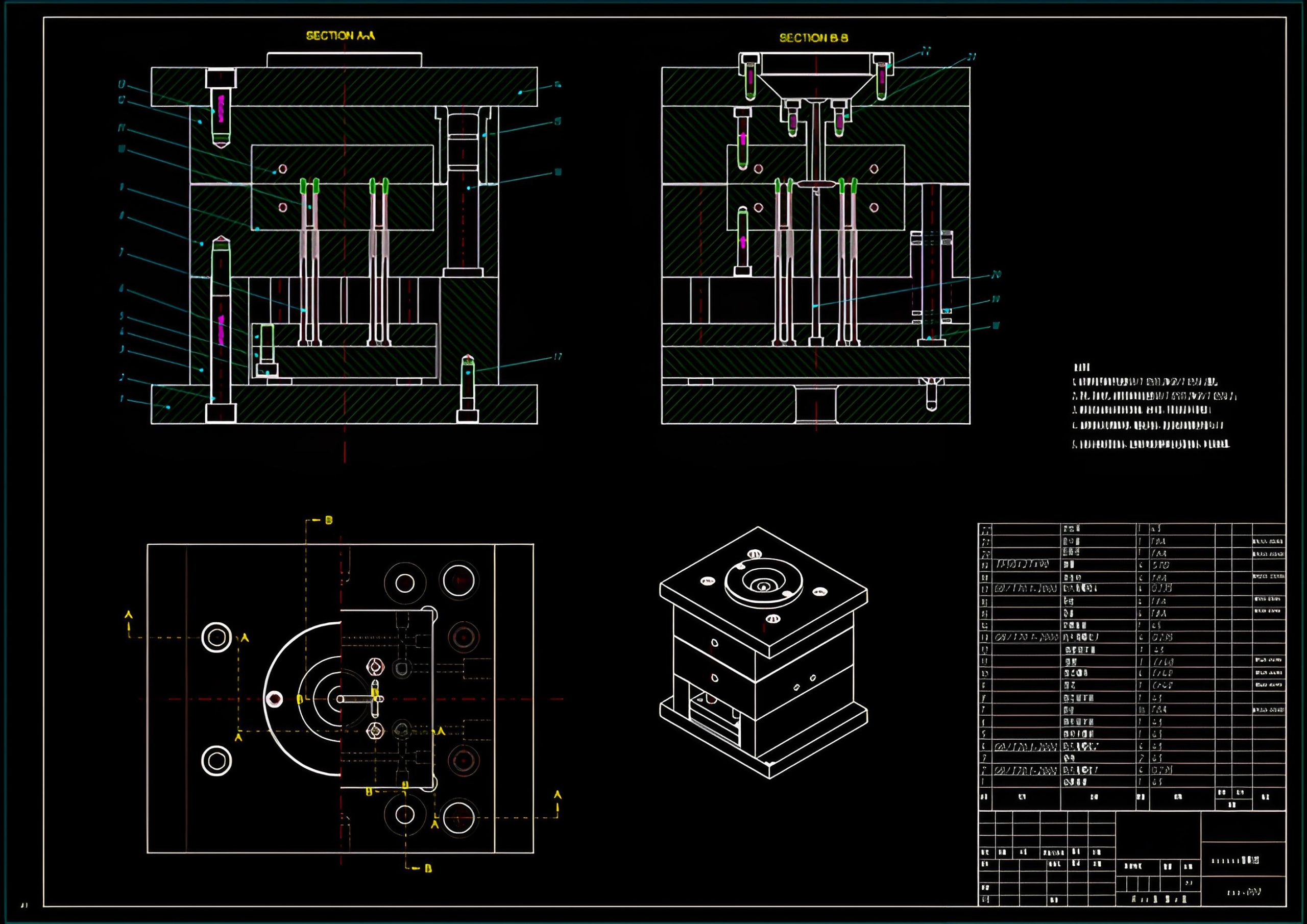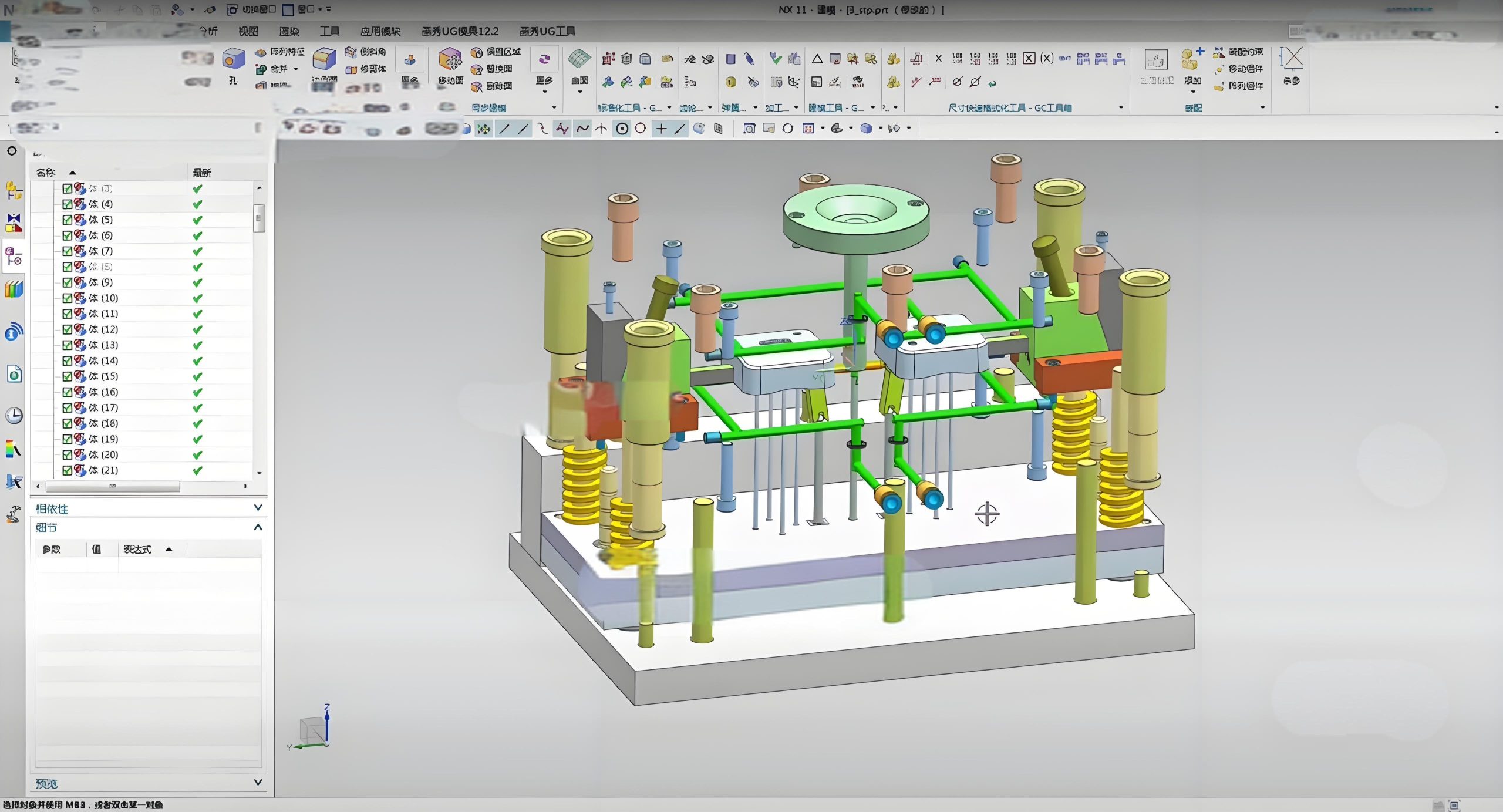Advanced Injection Mold Design Guide
Master the complete process of injection mold design with our comprehensive guide, covering everything from Cartographic standards to Demolding system design.
3D Visualization of Injection Mold Components
Industry-Proven Methods
Used by top manufacturers
Comprehensive Guide to Injection Mold Design
This guide covers the entire injection mold design process, from initial concept to final implementation. Whether you're a beginner or an experienced engineer, you'll find valuable insights and practical techniques to enhance your injection mold design skills.
10 Comprehensive Chapters
Detailed coverage of every aspect of injection mold design, from basic principles to advanced techniques.
Industry Best Practices
Learn from the latest industry standards and proven methodologies used by leading injection mold designers.
Practical Examples
Step-by-step examples and case studies to help you apply theoretical knowledge to real-world scenarios.
Injection Mold Design Chapters
Dive into our comprehensive guide covering every critical aspect of injection mold design, from foundational principles to advanced techniques.
Injection Mold Design Drafting Standards
Establishing standardized drafting practices is essential for clear communication in injection mold design. This chapter covers industry-standard symbols, dimensions, tolerances, and annotations used in injection mold design documentation.
Plastics, Plastic Parts, and Injection Molding Machines
Understanding plastic materials and injection molding machines is fundamental to successful injection mold design. This chapter explores various plastic polymers, their properties, and how they interact with different injection molding machine types.
Injection Mold Structural Component Design
The structural components of an injection mold provide the framework and support for all other parts. This chapter delves into the design of mold bases, plates, support pillars, and other critical structural elements.
Injection Mold Molding Part Design
The molding parts of an injection mold, including cavities and cores, directly shape the plastic part. This chapter focuses on the design considerations for these critical components, including material selection, surface finish, and cooling requirements.
Injection Mold Exhaust System Design
Proper排气系统 design is crucial for producing high-quality plastic parts. This chapter explores various排气 methods and systems, including venting channels, porous metal inserts, and gas-assisted molding techniques.
Injection Mold Side Parting and Core Pulling Mechanism Design
Parts with undercuts or complex geometries require specialized mechanisms for side parting and core pulling. This chapter covers various approaches, including slides, lifters, and hydraulic systems, to achieve successful part ejection.
Injection Mold Gating System Design
The gating system controls the flow of molten plastic into the mold cavity. This chapter examines different gate types, runner systems, and sizing calculations to ensure optimal filling and part quality.
Hot Runner Injection Mold Design
Hot runner systems offer significant advantages in injection molding, including reduced cycle times and material waste. This chapter covers the design considerations for hot runner systems, including nozzle selection, temperature control, and maintenance.
Injection Mold Temperature Control System Design
Precise temperature control is essential for consistent part quality and efficient production. This chapter explores cooling and heating systems, including cooling channels, temperature sensors, and thermal analysis techniques.
Injection Mold Ejection System Design
The ejection system is responsible for safely removing the molded part from the mold. This chapter covers various ejection methods, including ejector pins, sleeves, stripper plates, and their design considerations.
Additional Resources
Explore more in-depth guides, case studies, and expert advice on injection mold design.
View All ResourcesIn-Depth Look at Key Chapters
Explore detailed content from selected chapters to understand the critical aspects of injection mold design.

Injection Mold Molding Part Design
The molding parts of an injection mold, including cavities and cores, are critical components that directly determine the shape and quality of the final plastic part. Proper design of these elements ensures efficient production, part consistency, and mold longevity.
Material Selection
Choosing the right material for mold components is crucial. Factors such as hardness, thermal conductivity, corrosion resistance, and machinability must be considered based on the plastic material, part geometry, and production volume.
Surface Finish
The surface finish of cavities and cores directly impacts the appearance and functionality of the molded part. Different surface treatments, such as polishing, texturing, or plating, are applied based on part requirements.
Cooling System Integration
Efficient cooling is essential for reducing cycle times and ensuring uniform part shrinkage. Cooling channels are strategically designed within cavities and cores to maintain optimal temperature distribution.

Injection Mold Gating System Design
The gating system plays a vital role in the injection molding process, controlling the flow of molten plastic into the mold cavity. A well-designed gating system ensures complete filling, minimizes pressure drop, and reduces defects in the final part.
Gate Types
Different gate types, such as sprue gates, edge gates, submarine gates, and hot runner gates, offer unique advantages depending on part geometry, material properties, and production requirements.
Runner System Design
Runner systems, including natural runners and balanced runners, must be carefully designed to ensure uniform filling of multiple cavities and minimize material waste.
Gate Sizing Calculations
Proper gate sizing is critical to prevent issues such as jetting, weld lines, and excessive shear heating. Calculations consider factors like plastic viscosity, flow length, and part thickness.
Injection Mold Design Process
A systematic approach to injection mold design ensures efficiency, quality, and cost-effectiveness throughout the project lifecycle.
Project Analysis
Review part requirements, including material selection, dimensional tolerances, surface finish, and production volume to determine feasibility and initial design considerations.
Key Activities:
- Part geometry analysis
- Material compatibility assessment
- Cost estimation
Key Activities:
- Determine parting line
- Design cavity and core
- Plan ejection system
Conceptual Design
Develop the initial mold design concept, including determining the parting line, number of cavities, gating system, and ejection mechanism based on part analysis.
Detailed Design
Create detailed 3D models and 2D drawings of all mold components, including cavity, core, cooling system, gating system, and structural elements.
Key Activities:
- 3D modeling of all components
- Thermal and flow analysis
- Drafting with tolerances
Key Activities:
- Mold flow simulation
- Structural integrity analysis
- Cooling efficiency evaluation
Design Validation
Use simulation tools to analyze mold performance, including flow analysis, cooling efficiency, and structural integrity to identify and resolve potential issues.
Manufacturing Preparation
Prepare documentation for mold manufacturing, including material specifications, CNC programming, and quality control plans.
Key Activities:
- Material procurement
- CNC machining programming
- Toolpath optimization
What Industry Professionals Say
Hear from experienced injection mold designers and manufacturers who have used our guide to improve their processes.
Sarah Johnson
Senior Mold Designer
"This guide has been invaluable in my 15-year career as a mold designer. The detailed explanations and practical examples have helped me solve complex design challenges and improve my team's efficiency."
Michael Chen
Manufacturing Engineer
"As a manufacturing engineer, I rely on this guide to ensure our injection molds are designed for optimal production. The chapter on gating systems has significantly reduced defects in our parts."
Emily Rodriguez
Engineering Manager
"I've recommended this guide to all my new engineers. The systematic approach to mold design makes it easy for them to grasp complex concepts and apply them in real-world projects."
Frequently Asked Questions
Find answers to common questions about injection mold design and manufacturing processes.
Several key factors must be considered when designing an injection mold, including part geometry, material selection, dimensional tolerances, surface finish requirements, production volume, cooling requirements, ejection method, and gating system design. Each of these factors influences the overall mold design and can impact part quality, production efficiency, and cost.
Mold flow analysis is a critical tool in injection mold design that simulates the flow of molten plastic through the mold cavity. It helps designers predict and address potential issues such as air traps, weld lines, flow imbalances, and excessive shear heating. By optimizing the gating system, runner layout, and cooling channels based on analysis results, designers can improve part quality, reduce cycle times, and minimize material waste.
There are several types of gates used in injection molds, each with its advantages and ideal applications:
- Sprue Gates: Directly connect the sprue to the part, commonly used for large parts or simple geometries.
- Edge Gates: Located at the edge of the part, easy to machine and suitable for many applications.
- Submarine Gates: Cut into the mold surface, allowing automatic separation of the runner system from the part during ejection.
- Hot Runner Gates: Used in hot runner systems, eliminating the need for a cold runner and reducing material waste.
- Diaphragm Gates: Used for circular parts, providing uniform filling around the circumference.
Cooling system design is crucial in injection molding as it directly affects cycle time, part quality, and production efficiency. An efficient cooling system ensures uniform cooling of the plastic part, minimizing shrinkage, warpage, and internal stresses. Properly designed cooling channels maintain optimal temperature distribution, reducing cycle times by allowing faster solidification of the plastic. Inadequate cooling can lead to longer cycle times, poor part quality, and increased production costs.
The choice of material for injection mold components depends on factors such as part geometry, production volume, plastic material, and required surface finish. Common materials include:
- Tool Steels: Such as P20, H13, and S7, offer good strength, hardness, and wear resistance for most applications.
- Stainless Steels: Used for molds requiring corrosion resistance, such as those processing glass-filled plastics or PVC.
- Aluminum: Offers excellent thermal conductivity for rapid cooling, ideal for low-volume production or prototyping.
- Beryllium Copper: Used in areas requiring high thermal conductivity and good mechanical properties, such as inserts near gates.
Get Expert Assistance
Have questions about injection mold design or need personalized guidance? Our team of experts is ready to help you achieve optimal results for your projects.
Email Us
mold.design.experts@example.com
Call Us
+1 (555) 123-4567
Visit Us
123 Industrial Drive, Manufacturing City, State 12345